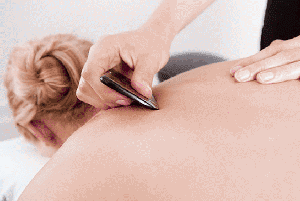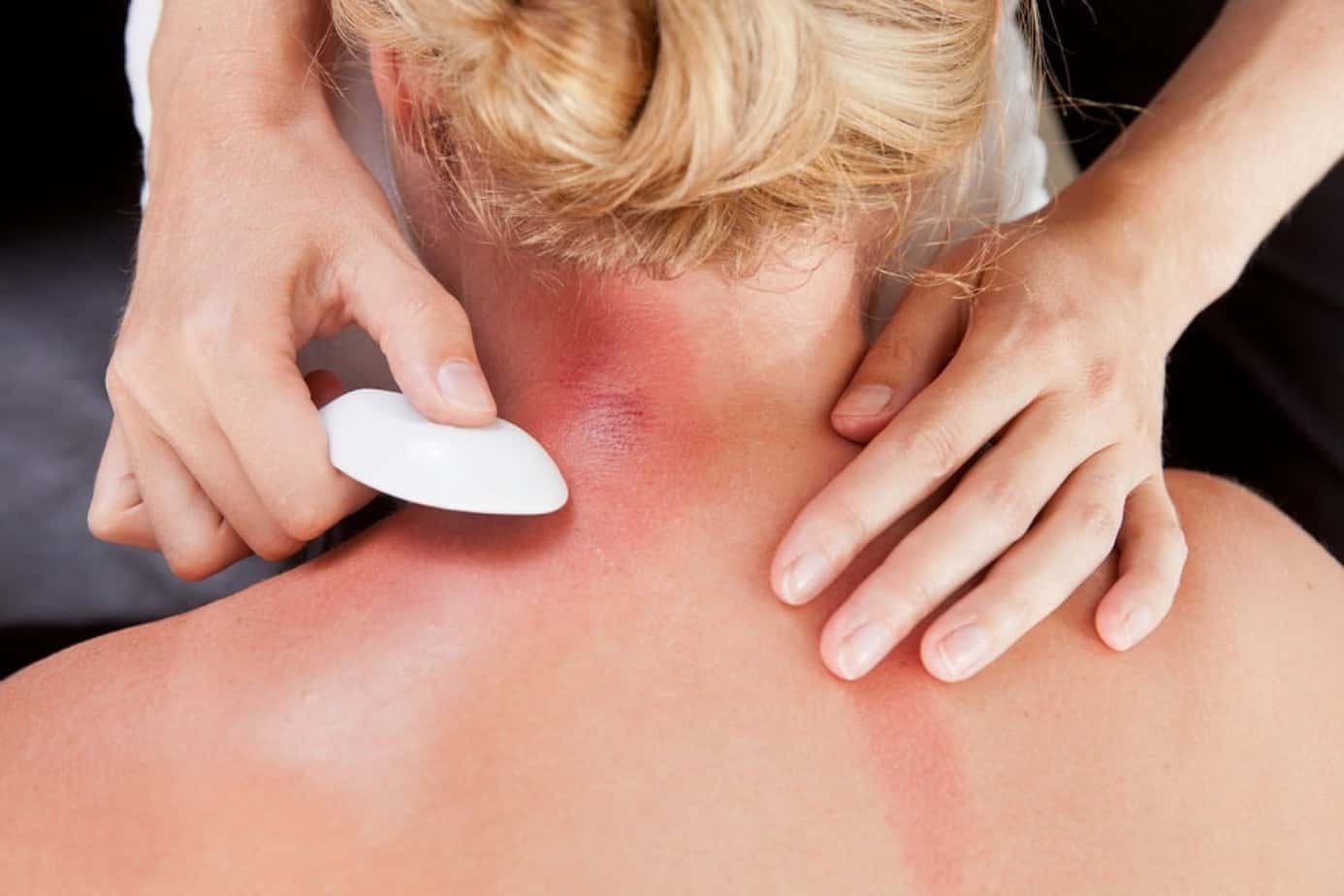28 Jul Top Gua Sha Treatment Questions Answered by Peter

28 Jul 2022
Gua sha seems to be all the rage at the moment, and you can find plenty on social media about the benefits of Gua Sha. Did you know that Gua Sha treatments are a time-honoured technique that has been around for thousands of years? The technique is essentially a tool-assisted type of massage that gently or firmly (depending on the condition) “scrapes/frictions, rubs or pushes” the skin, fascia and muscle of affected regions to improve and regulate blood circulation, reduce pain, induce collagen production and speed healing.
Gua Sha is a traditional technique in Chinese Medicine. The principle is that when your Blood is flowing freely throughout your body it functions optimally. When Blood becomes stagnant in certain areas of the body it is believed health problems can occur. A Gua Sha treatment primarily focuses on the muscles, fascia and skin, which all exist on the periphery of the body. Despite being on the superficial layers of the body, these tissues are all part of the acupuncture channels that connect the most superficial levels of the body to deep layers of the body. Therefore, if there is stagnation in the superficial layers of the body, it may not only affect a person musculo-skeletally, but it may also affect the flow of Qi and Blood to the internal organs and inhibit their functions. When we locate areas of stagnation in the superficial tissues of the body we may use cupping or Gua Sha treatment to regulate the area
A Chinese Medicine practitioner uses a smooth-edged Gua Sha instrument to gently scrape the areas of your body where the stagnant Blood is present to help boost the circulation, relieve pain and promote healing in that area.
You may be wondering is a Gua Sha treatment right for you?
You won’t always be recommended to have a Gua Sha treatment when you visit tonika health for your appointment. This all depends on the area of the body that is being treated and what your practitioner determines is best for your individual condition. Gua Sha is only suitable for very specific reasons and purposes and is usually used for stubborn and difficult to reach areas where cupping cannot address.
What can you expect when having a Gua Sha treatment?
The Gua Sha technique is overall a gentle experience and has different intensities depending on the tightness that is encountered in the area that is being treated. A Gua Sha treatment will typically start with a low intensity and will gradually build to promote circulation to help break up the areas that are knotted. Your acupuncturist will also use an oil or cream or potentially herbal oil or liniment to help the tool glide over the skin smoothly.
At first, the Gua Sha tool will be moved across the muscle knot that is encountered in a perpendicular direction to the muscle fibres so the knot breaks up. Once the muscle knot starts to break up the movement will be changed to follow the direction of the muscle fibres to lengthen them and ensure they are in the correct direction again, moving from inwards to outwards. The reason for the direction change is that if it is initially in the direction of the muscle fibres then it may cause the tissue tightness to increase.
 Please note that when you have a Gua Sha treatment there will be Gua Sha marks left on the area where you have had the treatment, which are a favourable sign that the treatment has mobilised stagnant Blood out of the tissues where the body can now flush and remove it and freshly oxygenated Blood can move into the area of the tissues where the stagnant Blood was mobilised from, thus regenerating the tissue and restoring its proper function.
Please note that when you have a Gua Sha treatment there will be Gua Sha marks left on the area where you have had the treatment, which are a favourable sign that the treatment has mobilised stagnant Blood out of the tissues where the body can now flush and remove it and freshly oxygenated Blood can move into the area of the tissues where the stagnant Blood was mobilised from, thus regenerating the tissue and restoring its proper function.
How will Gua Sha benefit you?
According to Chinese Medicine, Gua Sha can help with several health conditions, including musculoskeletal problems (like tightness in the shoulders, legs and back) as well as tension headaches, migraines, neck pain and swelling in your body. It is reported that Gua Sha helps with anxiety, fatigue and perimenopausal symptoms when used in conjunction with acupuncture.
The idea behind Gua Sha is that it assists the flow of Qi and Blood, and so helps to ensure a better blood supply and proper nerve conduction throughout the body. Alongside acupuncture, this treatment will get your body as close to a state of homeostasis as possible by addressing the muscle knots, soreness, weakness or pain that can come with stagnant Qi and Blood.

Should I do Gua Sha on my face?
There are so many videos and posts out there of influencers and the like promoting Gua Sha massage for their face. It is a very popular trend that has been on the rise for quite a while now. There is no doubt that Gua Sha has been proven to improve circulation and help relieve tension on the face, reduce puffiness and inflammation and can even help with sinus pressure. However, Gua Sha for the face should be done with measure and care as the musculature of the face is much thinner. Therefore, you will want to avoid applying too much pressure and certainly not the pressure that can be applied to a Gua Sha treatment on the body. In summary, the most important point to understand that Gua Sha for the face is a completely different treatment than Gua Sha on the body, and it aims to do something different.
If you would like to add Gua Sha for your face to your beauty regimen, then be careful not to drag your tool from the outside edges of your face. Use your nose as the middle point and work the tool gently outwards and upwards in a smooth, straight line. Do not rub the tool back and forth, up and down and in all different angles as that can stretch and aggravate your skin. The point is to move the tool in a smooth direction to cause a little redness, but not so much that it hurts.
You can apply a lotion or serum while doing Gua Sha massage on your face to help the tool glide more effortlessly on your skin. It is also important that you don’t go over any areas where the skin is too swollen, irritated, broken or wounded, or had any surgery of any kind.
What is the best Gua Sha tool?
You can use anything from a small wooden spoon to a gemstone Gua Sha tool, however it is important to keep the tool in a good and clean condition. You can clean your tool with either boiling water or watered-down bleach solution.
Gua Sha can be a very beneficial treatment when used in the right circumstances and in conjunction with other treatments by your health practitioner. There’s a reason why this Chinese Medicine technique is hundreds of years old!
Book an appointment with Peter online today!
You can see our list of our favourite acupressure points regularly updated on our Facebook and Instagram!



